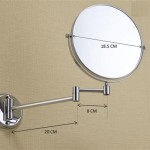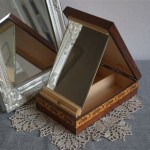How Do You Mount a Frameless Mirror to the Wall?
Frameless mirrors, with their sleek, modern aesthetic, are a popular choice for adding a touch of elegance and spaciousness to any room. However, mounting a frameless mirror can seem daunting, especially if you're used to the familiar hooks and brackets of framed mirrors. This article will guide you through the process of mounting a frameless mirror securely and flawlessly, offering clear instructions and valuable tips for success.
1. Preparing for Installation
Before you start, gather the necessary tools and materials. You'll need:
- A level
- A tape measure
- A pencil
- A drill
- Appropriate drill bits for your wall type (e.g., masonry drill bit for concrete walls, wood drill bit for drywall)
- Drywall anchors (if your wall is drywall)
- Screws (size and type will depend on the wall and mirror weight)
- Mirror mounting clips or adhesive mirror hangers (depending on the chosen method)
- A helper (optional, but recommended for larger mirrors)
Next, carefully assess your wall. Determine the material (e.g., drywall, plaster, concrete) and understand its strength and suitability for supporting the mirror's weight. For heavier mirrors or installations on weak walls, consider reinforcing the wall with a backing board for added support.
2. Choosing the Right Mounting Method
The most common mounting methods for frameless mirrors are:
a. Mirror Mounting Clips
These clips are metal brackets that attach to the back of the mirror and can be easily secured to the wall with screws. They are ideal for lighter mirrors and offer a secure and discreet mounting solution. To install, mark the mounting locations on the wall, drill pilot holes, and then screw the clips into place. Finally, simply slide the mirror onto the clips.
b. Adhesive Mirror Hangers
These adhesive hangers are strong, self-adhesive strips that attach to the back of the mirror and the wall. They are a convenient, hassle-free option for lighter mirrors and can be applied and removed without damaging the wall. Opt for heavy-duty adhesive hangers, especially for larger mirrors, to ensure a strong and reliable bond. Clean the surface thoroughly before applying the adhesive.
c. Z-Clips
Z-clips are metal clips that attach to the back of the mirror and are secured to the wall with screws. They provide a strong and secure hold for heavier mirrors. The clips are hidden behind the mirror, offering a clean and unobtrusive finish. Since Z-clips rely on screws, they require drilling into the wall. They offer a great balance of strength and visual appeal.
3. Installation Process
Once you've chosen your mounting method and prepared your wall, follow these steps:
- Mark the mounting locations: Using a level and tape measure, carefully mark the wall where you want to hang the mirror. Ensure that the marks are level and accurately aligned. If using mounting clips, mark the locations for each clip. If using adhesive hangers, use the provided template to guide placement.
- Pre-drill holes (if necessary): If using screws to secure the mounting clips or Z-clips, pre-drill pilot holes in the marked spots. This will prevent the wall material from cracking and make installation easier. Use a drill bit slightly smaller than your screw size. For drywall, use drywall anchors to ensure the screws have a secure hold.
- Secure the mounting clips or adhesive hangers: If using clips, screw them into the pre-drilled holes, ensuring they are firmly attached to the wall. If using adhesive hangers, clean the surfaces thoroughly, apply the adhesive pads to the back of the mirror, and then gently press the mirror onto the wall, ensuring even pressure across the entire surface.
- Hang the mirror: Carefully lift and position the mirror onto the mounting clips or adhesive hangers. If the mirror is large, consider asking a helper to assist with this step. Ensure the mirror is straight and level before letting go.
- Secure the mirror (if necessary): If using Z-clips, slide the mirror onto the clips and then secure the clips to the wall with screws. Ensure that the screws are fully tightened and the mirror is firmly held in place.
When mounting a mirror, it's crucial to choose the appropriate method based on the mirror's size, weight, and the type of wall. Follow the installation guidelines provided with the chosen mounting hardware. By taking the time to plan and accurately execute the installation process, you can enjoy a beautifully mounted frameless mirror that enhances the aesthetics and functionality of your space.

How To Install A Mirror Without Frame Merrypad

How To Hang A Frameless Mirror On The Wall With Pictures

How To Hang A Frameless Mirror On The Wall With Pictures

How To Hang A Frameless Mirror 2 Diffe Techniques

How To Hang A Frameless Mirror On The Wall With Pictures
:strip_icc()/DesireeBurnsInteriors1-f76d25cad90041c88fbae4a7dc10aab4.jpg?strip=all)
2 Simple Ways To Hang A Frameless Mirror

How To Hang A Frameless Mirror On Wall E Architect

Oval Frameless Wall Mirror Installation Fab Glass And

How To Hang A Frameless Mirror June 2024 Your Guide Hanging

In Depth Guide To Hang A Frameless Mirror On Wall Love Decor Mag








